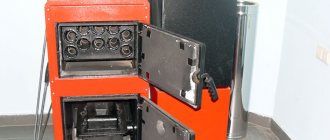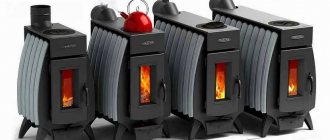Infrared (IR) heaters, so popular today, are fairly simple devices.
However, those wishing to install infrared heating in a private home are faced with a number of important issues. Is it possible to use such devices as the main heating?
What type and power of IR heater would be most suitable? Is this device capable of causing harm to human health? These and other white spots in the characteristics of IR heaters will be eliminated in the material below.
Principle of operation
Our Sun emits infrared waves in different spectrums - near, middle and far. Radiation with a wavelength of 8–14 microns is considered the most effective and safe. It is used in the production of equipment for infrared heating at home. Essentially, these heaters are a small sun that runs on electricity. Unlike conventional radiators (oil or electric), they do not heat the air - the radiation only heats the objects it hits, and these same objects become a source of heat. It is from them that the air in the room is heated, so the surfaces in the equipment operating area are always warmer than in other areas of the room.
Radiation intensity
When choosing infrared heating, you need to be careful with the power of the device. Normally, it should not exceed 350 W per square meter. If the radiating element is not heated above 100°C, then the surface of the heated objects will not be above 35°C. Properly designed and installed IR heaters can distribute heat evenly throughout the home, creating a comfortable microclimate.
Powerful infrared heating over a long period of time is dangerous for the skin and eyes. But household IR devices are adapted and the spectrum is configured for human use in residential conditions.
pros
When compared with traditional heating methods using convectors and oil radiators, the infrared panels in question have a number of advantages:
- Fast heating. When the equipment is turned on, the temperature in the area of its operation rises after 1–2 minutes. This is due to the fact that the rays are not scattered in the air, but reach their direct destination with little loss.
- Quiet operation and environmental friendliness - the operation of the equipment does not produce any sounds or vibrations. During the heating process, no harmful substances are released that could harm residents. Also, film infrared heating dries the air to a lesser extent, since heating occurs not from the hot surfaces of the radiator, but from warm pieces of furniture, walls, and floors.
- Wide application - these systems can be used not only in the home, but also in industrial premises, garages, utility rooms, and on the street.
- Effective air heating. Conventional radiators heat air, which rises, cools and falls down. As a result, the temperature at the feet is always lower than at the ceiling, which is not entirely correct. Infrared heaters direct rays from top to bottom, as a result of which the floor and pieces of furniture below are heated - heat emanates from them, so the air temperature below will be approximately equal to the temperature above. Also, convection currents (air circulation) are noticeably weaker.
- Unlike conventional electric convectors, infrared systems do not burn oxygen and do not dry out the air.
We can talk for a long time about the advantages of these systems.
Advantages over conventional heaters
One of the main advantages due to which many housewives look at these warming wall paintings and panels is their appearance and the ability to further decorate the interior of the apartment.
A single apartment owner can also choose the model he likes.
In addition to using them at home, they can also be used at work by hanging the picture directly near the workplace. In many offices, the use of fan heaters or heat blowers is officially prohibited due to their fire hazard.
But with such a heater there are no problems.
Forgot to install a heated floor or a separate radiator on your balcony or loggia?
And here this wonderful infrared device will help you out. Moreover, such warming paintings can be hung on walls made of any material.
The heating temperature of the surface of the film wall heater does not exceed 65-75 degrees. Therefore, it is simply impossible to get burned by accidental contact here.
Because of this, many people use them in children's rooms. For example, the most common oil radiators, which seem to be reliably protected on all sides and do not have open heating elements, are highly not recommended for use in children's rooms.
Versatility, health benefits, safety
Nobody bothers you to combine infrared heating batteries with conventional radiators - they can complement each other. With minimal effort, you can create a “warm island” in your home by installing 2-3 simple heaters, which will be directed to the kitchen corner, for example, or to the sofa. They are often installed in gazebos on the streets or in verandas. This will allow you to sit outdoors even in relatively cold weather.
Installation of infrared heaters is extremely simple - they can be placed on a special leg, hung on a wall or attached to the ceiling. They plug into an outlet and are immediately ready to use.
It is believed that infrared heating systems are more beneficial for human health. The sun's rays, when they hit a person's skin, penetrate inside and heat the blood vessels, causing heat to quickly spread throughout the body. However, there are often disputes that infrared heaters are harmful to health, which is not true. According to research by Japanese scientists, these devices serve as a preventive measure against many diseases.
Minuses
This equipment has not only positive qualities. There are also disadvantages:
- Spot action of the heater. If it works in one place, then the heat will be there; in other parts of the room the temperature is lower.
- Taking into account the fact that the rays of the heater pass through the air and warm the furniture and things that they fall on, it is possible that a plastic smell may appear. This is possible if the heater is directed at the chair on which the TV remote control is lying.
- Aesthetics suffer in some cases. Portable or even film heaters do not always fit aesthetically into the interior.
- High price of the equipment itself.
Considering how much an infrared heater consumes (depending on the power, consumption reaches 0.5–1.5 kWh or 50–200 Wh/m²), it cannot be called energy efficient. In terms of energy consumption, these devices are almost no different from conventional oil radiators or convectors. Efficiency can be achieved by insulating the room and installing heat-reflecting screens, but this is also possible with conventional radiators.
Varieties
There are three types of infrared heaters: film, panel, stationary. There are design features between them. Stationary ones are the simplest. These are separate devices that are installed on a leg (or attached to the wall) and plugged into a free outlet. They can be directed to the sofa, and then moved and plugged into another outlet.
Film and panel ones are not mobile. The latter can be installed in the ceiling or on the wall, while film ones can be installed on the ceiling or floor. Each type has its own characteristics.
Panel
When organizing infrared heating of a private house or apartment, panels are more often used, and films are less often used. Flat panel equipment allows you to save room space, as it does not involve changing the height of the room. This is a relevant solution for rooms with low walls.
They consist of:
- Heating element - heating element. It is made from one of three materials: quartz, ceramics, tungsten.
- A special panel that receives heat and transfers it to objects in the room.
- Insulation on the back side. It reflects heat waves from the back of the device and eliminates heat loss.
- Cases.
Infrared panels can be built into the ceiling or hung. Built-in ones are more popular and aesthetically pleasing. In this case we are talking about infrared plasterboard heating with special thermal insulation and graphite thread. They are also built into the walls around the perimeter of the room. Each panel has an average power of 150–200 W.
Film
This type of heater is ideal for organizing a warm corner somewhere on a loggia or veranda. It is used for zonal heating, although no one bothers to cover the apartment with “warm films” over the entire area.
In film infrared heating, the main material is a thin layer of graphite, which is applied to a thermoplastic film. Instead of graphite, a carbon thread can be used - when heated, it creates a heat flow. Note that film heaters create a single integral system, but it consists of separate modules. If some section fails, it is not difficult to replace it with a new one without compromising its integrity.
These panels do not have high power, so their efficiency is low. For this reason, they are used for local heating and are rarely installed along the entire perimeter of the apartment.
Types of IR heating
Ceiling option
Both infrared film and panels can be mounted on the ceiling of a residential building as a heating element. In the second case, installation is recommended with a ceiling height of at least 3.5 m: the heat they emit can cause discomfort (for example, if it hits the head) and takes up space. On the other hand, the panels can easily be dismantled and reinstalled in another room or taken with you when moving.
For a typical home, where the ceiling height is in the range from 2.7 to 3.2 m, an ergonomic solution is low-temperature infrared film, the beam flow of which is safe for residents. The heating element in such equipment is aluminum foil, which has the properties of a resistive screen.
Built-in temperature sensors in the ceiling system will allow you to save energy and maintain comfortable thermal conditions. The principle of their operation is simple: when the required temperature is reached, they will signal the system to turn off. Heating will start when the sensor signals a decrease in heat below a preset level.
Gas infrared heating
It is an integration of gas equipment and thermal energy of infrared radiation. The heating system consists of a mixing chamber and a ceramic plate. Gas and air are mixed in a chamber and then heated in a plate, which emits an infrared heat flow.
Gas infrared heating helps to quickly increase the temperature in the room, which provides significant superiority in severe frosts.
Heating with IR heaters
An infrared heater uses a tubular or spiral heating element. The standard model is a rectangular device with a metal body coated with heat-resistant enamel. In addition to the heating element, the heater contains a thermal insulator, a protective screen, fasteners, and power indicators.
The Russian market of infrared heating devices has a wide range. Today there are various color options; you can choose a model that suits the size, shape, weight and, of course, price.
IR devices are used for full-scale and local (spot) heating of a room. This is very convenient when you need to create comfort and warmth in open spaces of the house: on the terrace, in the workshop or in the storage room.
Danger of use and harm
People who choose a heating system want to know whether infrared heaters are harmful. If a person falls asleep on the beach, he can “burn” his skin, his temperature will rise, and even a serious burn is possible. The same is true with infrared heaters - if the panel or mobile equipment is directed at the sofa, then dozing on this sofa is dangerous to health (a person may overheat).
The biggest harm of infrared heating is drying out the skin. With prolonged contact of the skin with infrared rays, the moisture on the human body evaporates, and its replenishment is not carried out immediately. In extremely rare cases, this can lead to a burn (sleeping with the heater on), but more often than not, people’s skin simply dries out.
There is also information that infrared waves somehow affect the protein contained in the skin, and with prolonged exposure, such a heater harms the eyes: first of all, the retina suffers, and secondly, the lens. Sometimes the appearance and development of cataracts in people is associated with infrared heating, although all this has not been proven and is hardly true. Such damage can only be caused when the heater power is very high and a person remains under the waves for a long time.
Infrared heating of greenhouses in winter
But there is also infrared heating of greenhouses. This method can be called one of the latest technological achievements in terms of heating communications. This method is good because heat rays emit from the device, which transfer thermal energy to objects around. In this case, the air does not receive heat. The advantages of infrared heating include absolute harmlessness in relation to nature. The humidity level does not decrease. And by heating objects rather than air, it is possible to save money, even though the network runs on electrical energy.
The choice is large. There are many nuances that should be taken into account when choosing. In order not to get confused in the proposed methods, contact our specialists who will help in word and deed! — a guarantor of reliable and high-quality heating of a greenhouse and any other facility. We are professionals, and you can trust us with your greenhouse heating system. Call!
Connection
It’s not hard to figure out how to connect an infrared heater - it operates on a 220-230 V network, so the simplest and most obvious way is to plug it into an outlet. At least, mobile models are connected to sockets.
Panels or film systems are connected to each other in parallel, then connected to the thermostat (control panel), after which the wire (phase, neutral and ground) is pulled directly to the machine located in the distribution panel. This allows you to bypass all the wiring brought into the apartment or house. Most often, a separate automatic machine is installed to heat the apartment, which is triggered when there is a heavy load or a short circuit. The rest of the wiring in the apartment is connected to another machine. This allows you to correctly distribute the loads generated during the operation of infrared heaters. If you “hang” a powerful heating system on the existing apartment wiring, then when the heating system and, for example, an electric oven, air conditioner or iron are operating simultaneously, overloads are possible. In rare cases, this leads to a fire, although most often automatic devices are triggered.
However, to create a cozy warm corner with a small number of panels with a total power of up to 2 kW, it is possible to connect an infrared heater to an outlet, that is, the general electrical wiring in the house.
Optimal selection criteria
Acting as an “earth-sun” model, the PLEN system, when installed in May or October, will simply maintain the thermal regime that the house was saturated with during the summer-spring period. This heater also works effectively in rooms with good thermal insulation.
We recommend: Features of exhaust pipes for heating boilers
This saves energy, and the heating can be turned off periodically. And less time will be spent heating the resistor film - a reduction of approximately 10% of the main time costs. The heating turns off once the space has reached the desired temperature. You will need to turn it on periodically and only for 3-15 minutes.
Best models
Various manufacturers in Europe and Russia produce home heating equipment. In this rating of infrared heaters, the best models that have collected positive customer reviews are selected.
1st place - Ballu BIH-AP4-0.8-W
The cost of this model is around 3000 rubles. This heater is designed to heat an area of 16 square meters, connects to a 220/230 V system and is installed at a recommended height of 2.4–3.5 meters, its power is 800 W.
Based on reviews, we find out that this is an effective and high-quality model that warms up the room quickly enough. The set includes durable brackets - with their help the device can be rotated. This model is mainly used as an additional source of heating in any room, but is also suitable for a garage and for installation outdoors - the waterproof housing will not allow rain to spoil it.
2nd place - Almac IK5
This infrared heating battery has a lower power of 500 W. It effectively heats 10 square meters, so in a single copy it is used as an additional heat source. However, three similar models can easily cope with heating a large living room or hall.
Judging by the reviews, the device effectively copes with its task, is easily attached to the wall or suspended from the ceiling, and is simply adjustable - it is enough to set 23 degrees during the day, 20 at night. The only drawback is the complexity of the connection. And although the instructions indicate how to install an infrared heater, the kit does not include wires and a thermostat, so without the appropriate knowledge and experience you cannot connect it - you will have to call a specialist, but you can turn a blind eye to this, given the low price of around 2,500 rubles.
3rd place - Peony Thermo Glass P-10 (7000 rubles)
The model is from the Russian one, which has become popular on the Russian market. Power – 1000 W, heating area – 20 m². The device is connected via a regular 220/230 V socket and is equipped with electronic control and a thermostat, which allows you to accurately regulate the power and heating temperature. It also received protection against overheating, which ensures minimal safety and increases its service life. The infrared heater can be installed on the ceiling at a height of 2.3–3.5 meters.
According to reviews, the model is effective: it quickly heats surrounding objects, operates silently and provides soft and pleasant warmth. This is an advantage, since some models heat aggressively.
The disadvantage is the equipment and high price. The model is significantly more expensive than similar heaters, and the kit does not include any cables. The device also needs to be looked after - if you do not systematically wipe the dust off it, then over time a burning smell will appear.
There are also many low-quality products on the market with the CE mark. In one case it means “Conformite Europeenne”, in the other it means “China Export”. Try to choose reliable equipment, since heating devices in the house always pose a certain danger.
Main technical characteristics
Despite the large number of PLEN manufacturers, the main parameters of their products are quite similar, here are the main ones:
- Power specifications: 220-240 VAC, 50 Hz.
- Maximum power ≈ 200 W/m2.
- Average daily power is 25-65 W/m2.
- Permissible heating temperature 150°C, melting point 250°C.
- The temperature of the heating elements is 45-50°C.
- Width 0.50-1.0 m.
- Roll length – up to 50 m.
- The maximum laying length is 8 m.
- Thickness – up to 0.4 mm.
- Heating inertness – no more than 3 minutes.
- Efficiency up to 90%.











